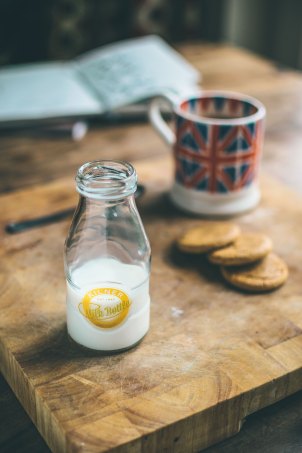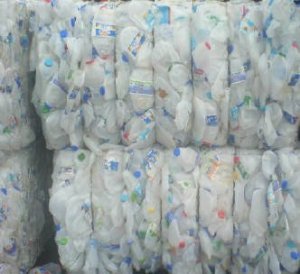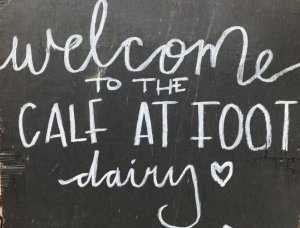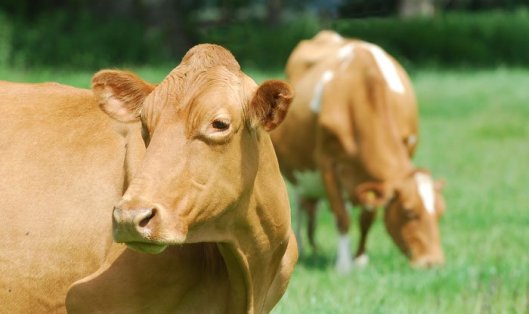MILK


My family loves milk, on breakfast cereal, in tea and coffee or just for drinking, and milk is good for us, however several things concerned us. Most commonly available milk comes in single use plastic containers, we worked out that using two 2ltr containers a week would generate over 44kg of plastic waste a year. We felt this was an unacceptable environmental cost.

We are lucky enough to live in an area where a milkman delivers in glass bottles, so we could just cut the plastic out but we wanted to do more.
We also know that other than some gold top (Channel Island milk) all milk commercially available by mainstream means has been highly processed and on health grounds that was something else we wanted to get away from.
A little something about milk
Supermarket / mainstream milk – The main sellers are;
Skimmed (Red top) this is fat reduced, pasteurised and homogenised.
Semi-skimmed (Green top) is fat reduced, pasteurised and homogenised.
Whole milk (Blue top) is fat reduced (standardised), pasteurised and homogenised.
Jersey milk (Gold top) is pasteurised, and comes either homogenised or not.
So all supermarket milk except some Gold Top has been processed to remove some of the fat.
ALL of it has been pasteurised (flash heat treated and rapidly cooled) and (excluding some Gold Top) homogenised.
So how is this done?
The process of pasteurisation involves heating milk to 71.7°C for at least 15 seconds (and no more than 25 seconds). Because of the nature of the heat treatment it sometimes referred to as the ‘High Temperature Short Time’ (HTST) process. Once the milk has been heated, it is then cooled very quickly to less than 3°C. The equipment which is used to heat and cool the milk is called a ‘heat exchanger’. Pasteurisation kills bacteria and prolongs the usable life of the milk product, the majority of milk bought in the UK is pasteurised.
Homogenization today is usually a two step process. The first stage pushes milk through small, tapered tubes or pores. As the diameter shrinks and the flow of milk remains constant, pressure builds up and fat globules break apart in the turbulence.
The higher the pressure, the smaller the particles. How much pressure? Typically 2,000-3,000 pounds per square inch (psi), although some super homogenizers work at over 1000 times atmospheric pressure 14,500psi and higher.
Before homogenization, fat globules range in size from 1-10 microns (a micron = ~0.00004 inch). After, the size range is reduced to 0.2-2 microns.
As the much smaller fat globules begin to reassemble, they include fragments of whey and casein in their walls. Some are completely surrounded by a layer of protein. The tendency is for these new, chemically altered globules to clump together.
Stage two of the homogenization process breaks up this unwanted assembly and makes sure everything stays in solution.
Some researchers believe that these protein-heavy fat globules can potentially increase homogenized milk’s ability to cause allergic reactions. Numerous animal studies confirm this.
Source www.raw-milk-facts.com
So thinking long and hard about this we decided to actively avoid plastic packaged homogenised milk. We decided to start buying farm fresh milk, both Pasteurised milk and RAW MILK. Our personal preference is raw milk as we feel this benefits our gut health, but the most important reason for our purchasing choices are to source locally, buy as high a quality, minimally processed, and sustainably produced milk as possible, while remaining as cost neutral is we can.
So we now do a weekly milk run, we are lucky to have a number of dairy farm shops locally. We generally pick up four to five litres at a time in our own glass refillable bottles.
This often mostly coincides with work trips, or we plan a family day and get it on our way back. This means we benefit but don’t incur a massive carbon footprint on the milk we buy.
We have pretty much got this budget neutral, the cost is the same as previously buying supermarket gold top, but environmentally it is a zero food miles product, and it is not messed with. I have not liked the taste of milk since I was made to drink luke warm third pints of it at school, but even I think it tastes good!
We use a few dairies regularly but others are available, details of raw milk suppliers across the UK can be found at the Raw Milk producers association website, all farm gate suppliers can be found on the farmers weekly website, obviously goats milk is also available. prices vary considerably dependant on supplier (Jersey milk can attract a significant premium) and delivery costs are very high if you order courier delivery.
Where we buy our milk
Calf at foot dairy, Somerleyton, Suffolk.

Coston Hall Farm (10 minutes from Wymondham off the A11 in Norfolk)
https://costonhalldairy.co.uk/
![]()
Fen Farm Dairy (not far from Bungay) http://fenfarmdairy.co.uk/

Old Hall Farm (Woodton near Bungay) http://www.oldhallfarm.co.uk/

Colletts Farm (Wormingford near Colchester) http://www.collettsfarm.co.uk/

Bradfields Farm, North Benfleet near Basildon.

Suffolk Farmhouse Cheeses, off the A140 near Earl Soham Suffolk. Suffolk farmhouse cheese

Where possible we reuse our glass bottles which we sterilise between uses. We take them to refill where vending machines are located at the farms, ensuring bottles our are clean and sterile is vital!!! We dishwash them, and scald them at home before refilling.
Its a nice simple process, and gives us lovely milk at minimal environmental cost… All part of living gentler.
Some low volume raw and pateurised milk suppliers still use plastic containers, there are sound business reasons for this mainly around commercial sterilisation of reuseable glass bottles, and cost to the farmer of single use glass bottles. We understand this and still support their efforts to work as sustainably as possible and produce a quality product.
Milk pricing
There is another reason for buying milk direct from the farm, and over and above our personal reasons, it is the support we give our farmers. In March 2020 the average price paid to dairy farmers was just 28.63 pence per litre, being an average means some get more, and some get less possibly as low as 20 pence a litre. When we buy from the farm the farmer gets every penny we pay. We would rather give that extra 70 odd pence to the farmer than lining corporate pockets.
Some of the often claimed benefits of raw milk;
Raw milk consists of important enzymes that aid in assimilating the nutrients present in milk. Possibly the most important is lactase enzyme that helps digest lactose milk sugar. After using raw milk many people who thought they couldn’t have dairy as they are lactose intolerant, are really enjoying milk again. Maybe it’s a case that they are pasteurized milk intolerant?”
“Raw milk serves as one of the best sources for calcium consumption.”
“One of the major raw milk drinking advantages is that it contains the beneficial bacteria both in terms of gut health and fighting infection, which otherwise get destroyed, when the milk undergoes pasteurisation process.”
Source Hook and Son website.
About Raw Milk
We give our choices careful consideration and know for some groups of people there can be potential health implications (my 89 year old mother loves it, and says how it tastes like the milk from her childhood!). Anyone deciding to buy raw milk should read and understand the specific government guidance advising who should not have raw milk before making their own decisions.
We know for some people reading this, raw milk not an option either on health, or availability grounds (for example Raw Milk sales are prohibited in Scotland, Australia, Canada, and some parts of the USA), in those cases we firmly recommend farm gate sold pasteurised milk.
For those in the UK allergic to cows milk, sources of sheep’s milk and cheeses are can be found on the Sheep Dairy producers association website
#livinggentlermilk
It is worth noting hete that Raw Milk is not available in Scotland, or some countries elsewhere in the world.

